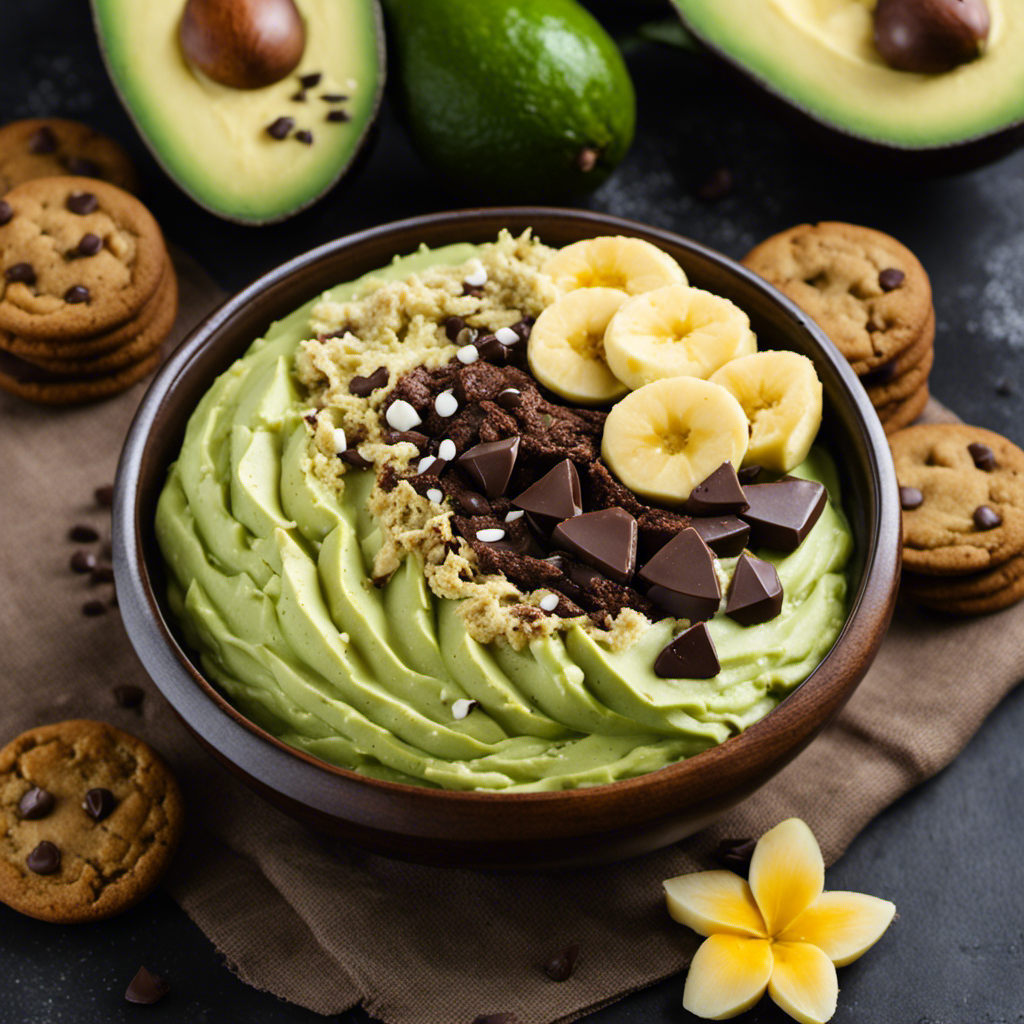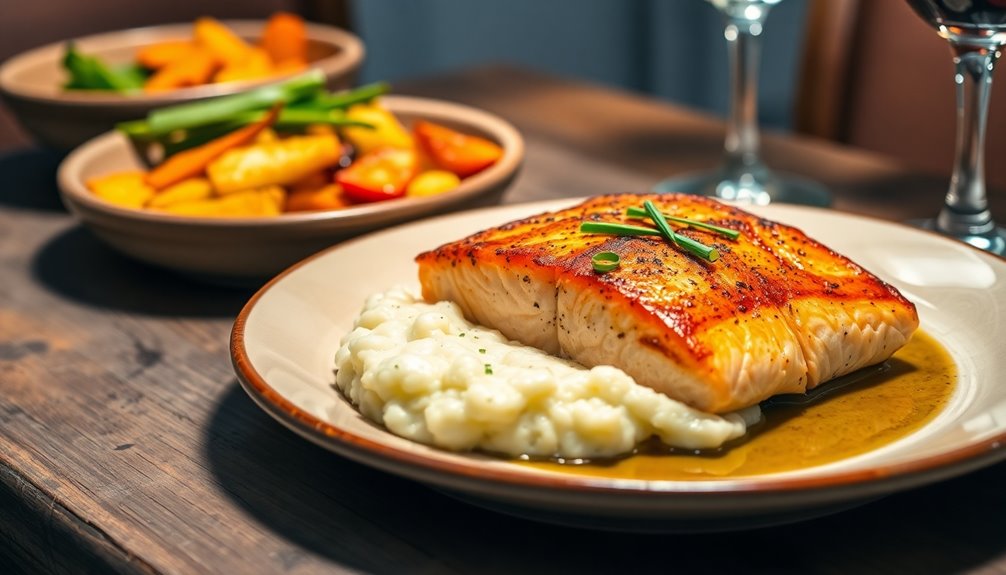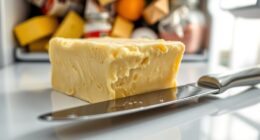While standing in my kitchen, pondering the lack of butter in my pantry, I couldn’t help but wonder: is it possible to still create tasty cookies without this essential ingredient?
Intrigued by the challenge, I embarked on a culinary adventure, exploring the world of butter alternatives. Join me as I unveil the secrets to creating delectable cookies, sans butter.
Discover the essential ingredients, learn how to substitute butter with oil, and dive into the realm of non-dairy butter substitutes.
Get ready to elevate your cookie game, one butterless batch at a time.
Key Takeaways
- Butter alternatives such as margarine, coconut oil, avocado puree, applesauce, Greek yogurt, and olive oil can be used in cookies to accommodate dietary restrictions or preferences.
- Using alternative fats can provide similar texture and taste results in cookies, allowing for customization based on taste and dietary needs.
- Vegetable shortening, coconut oil, canola oil, and non-dairy substitutes like avocado, mashed bananas, margarine, and nut butters can be used to substitute butter in cookie recipes.
- Experimenting with different fats and ratios helps to find the perfect substitution for butter in cookies, resulting in a wide range of delicious options for butterless baking.
The Importance of Finding Butter Alternatives
Finding butter alternatives is crucial when making cookies without butter. As someone who follows a vegan diet, I am always on the lookout for vegan alternatives in my baking.
One popular option is using margarine instead of butter. Margarine is a plant-based spread that can mimic the creamy texture and rich flavor of butter. It is made from vegetable oils and often fortified with vitamins A and D.
When baking with margarine, it is important to choose a brand that is labeled as vegan, as some margarines may contain animal-derived ingredients. Additionally, it is essential to use margarine that has a similar fat content to butter, as this will ensure the proper texture and structure of your cookies.
Why Choose to Make Cookies Without Butter
There are several reasons to opt for baking cookies without butter.
One of the main reasons is finding alternative fats for baking. Butter is a common ingredient in cookies, but some people may have dietary restrictions or preferences that require them to avoid it. By using alternative fats such as vegetable oil, coconut oil, or margarine, you can still achieve delicious cookies without compromising on taste or texture.
Speaking of texture, fats play a crucial role in determining the texture of cookies. They contribute to the spread and tenderness of the baked goods. While butter adds a rich and creamy texture, other fats can provide similar results.
It’s important to experiment and find the right fat substitute that suits your taste and dietary needs.
Essential Ingredients for Butterless Cookies
Using alternative fats in cookie recipes can help achieve delicious results without the use of butter. When finding butter alternatives, it’s important to consider healthy butter substitutes that will still provide the desired texture and flavor in your cookies. Here are some essential ingredients that can be used as substitutes for butter in cookie recipes:
| Alternative Fat | Texture | Flavor |
|---|---|---|
| Coconut oil | Soft and chewy | Slightly nutty |
| Avocado puree | Moist and fudgy | Mild and creamy |
| Applesauce | Moist and cakey | Subtle sweetness |
| Greek yogurt | Soft and tender | Tangy |
| Olive oil | Crispy and delicate | Light and fruity |
Substituting Butter With Oil: the Basics
To achieve the desired texture and flavor in your cookies, you’ll want to know the basics of substituting butter with oil. When replacing butter with oil, it’s important to understand that the texture and taste of your cookies may slightly differ. However, by using the right techniques and ingredients, you can still achieve delicious results.
One option is to use vegetable shortening as a substitute for butter. It has a similar texture and can enhance the flavor of your cookies.
Another alternative is to try nut-free alternatives, such as coconut oil or canola oil. These oils can add moisture and richness to your cookies without compromising the taste.
Experimenting with different oils and ratios will help you find the perfect substitution that suits your preferences.
Exploring Non-Dairy Butter Substitutes
When it comes to finding healthy alternatives for butter, there are several non-dairy substitutes that can be used. These substitutes not only provide a creamy and rich flavor, but also offer a range of health benefits.
In this discussion, we will explore the best non-dairy substitutes for butter, highlighting their nutritional value and how they can be used in various recipes.
Healthy Alternatives for Butter
You can try substituting butter with healthier options like avocado or coconut oil. These alternatives not only provide a delicious flavor to your cookies but also offer some nutritional benefits.
Here are three nut-free alternatives that you can use in your baking:
-
Avocado: Mash a ripe avocado and use it as a butter replacement in your cookie recipe. Avocado is rich in healthy fats and adds a creamy texture to your cookies.
-
Coconut oil: Swap out butter for coconut oil. It has a mild coconut flavor that pairs well with many cookie recipes. Make sure to use the same amount of coconut oil as you would butter.
-
Mashed bananas: For a naturally sweet and moist alternative, try using mashed bananas. They add a subtle banana flavor to your cookies and work well in recipes that call for a softer texture.
Best Non-Dairy Substitutes
Now let’s dive into the world of non-vegan butter options, specifically the benefits of using margarine as a substitute.
Margarine is a popular choice for those looking to avoid using butter in their cookie recipes. It is made from vegetable oils, which means it is completely dairy-free and suitable for a vegan or lactose-free diet.
One of the main benefits of using margarine is its lower saturated fat content compared to butter. Saturated fats can raise cholesterol levels and increase the risk of heart disease, so opting for a lower-fat alternative can be beneficial for your health. Margarine also contains no cholesterol, making it a heart-healthy choice.
Additionally, margarine spreads easily when baking, creating a smooth and creamy texture in your cookies. It adds moisture to the dough, resulting in soft and chewy treats.
Using Nut Butters in Cookie Recipes
Using nut butters in cookie recipes adds a rich and creamy flavor to the dough. It’s a great alternative to using butter and can give your cookies a unique twist.
Here are three nut butter options that can be used as alternative cookie spreads:
-
Almond Butter: Made from ground almonds, almond butter adds a nutty and slightly sweet taste to your cookies. It also provides a good source of healthy fats and protein.
-
Peanut Butter: A classic choice, peanut butter brings a familiar and comforting flavor to your cookies. It pairs well with chocolate chips or oatmeal, creating a delicious combination of sweet and salty.
-
Cashew Butter: Creamy and smooth, cashew butter adds a delicate and buttery flavor to your cookies. It’s a great option for those who prefer a milder nut taste.
Using nut butters in cookie recipes not only adds flavor, but also provides a healthier alternative to traditional butter. Another healthy substitute for butter is applesauce, which can be used in baking.
Baking With Applesauce: a Healthy Butter Substitute
So, let’s talk about the role of applesauce in baking and its health benefits.
Applesauce is a fantastic ingredient to use in baking as it acts as a healthy substitute for butter, adding moisture and a subtle apple flavor to your treats. Not only does it reduce the fat content in your baked goods, but it also provides additional fiber and nutrients.
When substituting applesauce for butter in a recipe, you’ll typically need to reduce the amount of sugar and adjust the baking time.
Applesauce’s Role in Baking
Applesauce can be a great substitute for butter in baking cookies. Here are three reasons why:
-
Health benefits of applesauce: Unlike butter, applesauce is low in fat and calories, making it a healthier option for those watching their waistline. It also contains vitamins and minerals that are beneficial for overall health.
-
Recipe adjustments when substituting: When using applesauce as a butter substitute, you’ll need to make a few adjustments to your recipe. Reduce the amount of sugar, as applesauce adds natural sweetness. You may also need to adjust the baking time and temperature, as applesauce can affect the texture and moisture content of the cookies.
-
Texture and flavor: Applesauce adds moisture to the cookies, resulting in a soft and chewy texture. It also adds a subtle hint of apple flavor, which can enhance the overall taste of the cookies.
Health Benefits of Applesauce
Applesauce’s health benefits include being low in fat and calories, making it a healthier option for baking. When it comes to applesauce recipes, it’s important to consider its nutritional value.
Applesauce is packed with vitamins and minerals, such as vitamin C and potassium. It also contains dietary fiber, which aids in digestion and helps maintain a healthy weight. Additionally, applesauce is a good source of antioxidants, which can help reduce the risk of chronic diseases.
Incorporating applesauce into your baking not only adds moisture and flavor, but also boosts the nutritional profile of your treats. Now let’s explore how to make recipe adjustments when substituting butter with applesauce, ensuring your baked goods turn out just as delicious.
Recipe Adjustments When Substituting?
When substituting butter with applesauce in your recipes, you’ll need to make adjustments to ensure the desired texture and taste are achieved. Here are three recipe modifications to consider:
-
Reduce the amount of liquid: Applesauce contains moisture, so you may need to decrease the amount of liquid in the recipe to prevent the batter from becoming too wet.
-
Increase the leavening agents: Butter helps create a tender texture in baked goods, so when using applesauce, you may need to increase the amount of baking powder or soda to achieve a similar result.
-
Adjust the baking time: Applesauce can make baked goods denser, so you might need to bake your recipe for a little longer than usual to ensure it is fully cooked.
By making these recipe modifications and using alternative ingredients like applesauce, you can still enjoy delicious treats with a healthier twist.
Now, let’s talk about enhancing flavor with coconut oil.
Enhancing Flavor With Coconut Oil
Using coconut oil instead of butter can add a rich and tropical flavor to your cookies. When it comes to finding alternatives for butter in baking, coconut oil is a popular choice.
Not only does it provide a unique taste, but it also offers several benefits. One of the main advantages of using coconut oil in baking is its high smoke point, which means it can withstand high temperatures without breaking down or producing harmful compounds.
Additionally, coconut oil contains healthy saturated fats that can help improve cholesterol levels and promote heart health. It also adds moisture to your baked goods, resulting in soft and tender cookies.
The Magic of Avocado in Cookie Dough
I absolutely love using avocado as a butter substitute in my baking. Not only does it add a delicious creaminess and texture to the dough, but it also brings a host of health benefits.
Avocado is packed with heart-healthy monounsaturated fats, fiber, and vitamins, making it a nourishing choice for any recipe.
Avocado as Butter Substitute
To substitute butter in your cookie recipe, you can use mashed avocado as a healthier alternative. Avocado is not only rich and creamy, but it also offers numerous nutritional benefits. Here are three reasons why you should consider using avocado in your next batch of cookies:
-
Avocado nutrition: Avocados are packed with heart-healthy monounsaturated fats, which can help lower bad cholesterol levels. They are also a good source of fiber, potassium, and vitamins C, E, and K.
-
Healthier recipe ideas: Apart from replacing butter in cookie recipes, avocados can be used in various other baked goods like brownies and muffins. You can also add them to smoothies, salads, or even make avocado chocolate mousse.
-
Creamy texture: Mashed avocado adds a creamy texture to your cookies, making them moist and delicious. The natural fats in avocados provide a similar richness to butter, while also reducing the overall saturated fat content.
Health Benefits of Avocado
Now that we’ve discussed how avocado can be used as a butter substitute in baking, let’s delve into the health benefits of this versatile fruit.
Avocados are not only delicious, but they also offer a multitude of nutritional advantages. Packed with heart-healthy monounsaturated fats, avocados can help lower bad cholesterol levels and reduce the risk of heart disease. They are also a great source of vitamins C, E, and K, as well as potassium and fiber.
Incorporating avocados into your diet can promote healthy digestion, boost your immune system, and even contribute to weight management. Avocado toast has become a popular breakfast choice, offering a satisfying combination of creamy avocado and crunchy toast. For a refreshing twist, you can also enjoy avocados in smoothies, creating a creamy and nutritious treat.
Creaminess and Texture Enhancement
Enhance the creaminess and texture of your dishes by incorporating avocado as a substitute for butter. Avocado is not only a healthier alternative, but it also adds a rich and velvety consistency to your recipes.
Here are three creaminess techniques and texture tricks using avocado:
-
Avocado puree: Mash ripe avocado until smooth and use it as a 1:1 replacement for butter in recipes. It will lend a creamy texture without altering the taste.
-
Avocado oil: Substitute melted avocado oil for melted butter in recipes. The oil adds a silky texture while keeping the dish moist and flavorful.
-
Avocado as a spread: Instead of using butter as a spread on toast or sandwiches, try using mashed avocado. It provides a creamy and indulgent taste while being packed with healthy fats and nutrients.
Achieving Moisture and Texture With Greek Yogurt
You can achieve moisture and texture in your cookies by using Greek yogurt instead of butter. Greek yogurt is a great alternative ingredient that can add a creamy and moist element to your baked goods. Not only does it provide a tangy flavor, but it also helps to keep your cookies soft and tender. When using Greek yogurt in your cookie recipes, it’s important to make a few adjustments. Since Greek yogurt has a higher water content than butter, you may need to reduce the amount of liquid in your recipe. Additionally, you can replace the butter with an equal amount of Greek yogurt in your recipe. Here’s a table that compares the moisture and texture achieved by using Greek yogurt versus butter in cookies:
| Ingredient | Moisture | Texture |
|---|---|---|
| Greek Yogurt | High | Creamy |
| Butter | Moderate | Rich |
The Science Behind Using Silken Tofu in Cookie Recipes
Using silken tofu in cookie recipes can provide a unique texture and moisture to your baked goods. As someone who loves experimenting with different ingredients in my baking, I have discovered the benefits of using silken tofu as an egg substitute.
Here are three reasons why you should consider incorporating silken tofu into your next batch of cookies:
-
Moisture: Silken tofu contains a high water content, which helps to keep your cookies moist and soft. This is especially beneficial when you’re making cookies without butter, as it can be challenging to achieve the same level of moisture.
-
Texture: The smooth and creamy consistency of silken tofu adds a velvety texture to your cookies. It creates a slightly denser and chewier bite, making them even more satisfying to sink your teeth into.
-
Healthier Option: Silken tofu is low in fat and cholesterol-free, making it a healthier alternative to traditional egg substitutes like oil or butter. It also adds a good amount of protein to your cookies, making them more filling and nutritious.
Incorporating silken tofu into your cookie recipes not only adds a unique twist but also offers several benefits in terms of texture, moisture, and health. Give it a try and see the difference it makes in your baked goods!
Frequently Asked Questions
Can I Use Margarine Instead of Butter in Cookie Recipes?
Yes, you can use margarine instead of butter in cookie recipes. Margarine is a suitable substitute, but it may affect the texture and flavor of the cookies. Consider the pros and cons of using margarine in baking.
What Are the Health Benefits of Using Non-Dairy Butter Substitutes in Cookies?
Using non-dairy butter substitutes in cookies has health benefits. They offer nutritional value, like being lower in saturated fat. Additionally, they accommodate dietary restrictions, such as lactose intolerance or veganism.
Can I Replace Butter With Vegetable Shortening in Cookie Recipes?
Yes, you can replace butter with vegetable shortening in cookie recipes. Vegetable shortening is a good substitute for butter as it provides a similar texture and moisture. However, keep in mind that shortening may affect the flavor of the cookies.
How Does Using Applesauce as a Butter Substitute Affect the Texture of Cookies?
Using applesauce as a butter substitute in cookie recipes can affect the texture. It adds moisture and tenderness, resulting in softer and chewier cookies. Other butter substitutes like vegetable shortening or coconut oil can also alter texture.
Can I Use Yogurt as a Butter Substitute in All Types of Cookies?
Yes, you can use yogurt as a butter substitute in most cookie recipes. It adds moisture and a tangy flavor. Other alternatives to butter in cookie recipes include applesauce, avocado, and coconut oil.
Conclusion
In conclusion, embarking on the journey of making cookies without butter has opened my eyes to a world of possibilities.
Just like a caterpillar transforming into a beautiful butterfly, these butterless cookies have transformed my baking experience.
With the right substitutes like oil, non-dairy butter alternatives, coconut oil, avocado, Greek yogurt, and silken tofu, I have discovered a whole new realm of flavors and textures.
So go ahead and spread your baking wings, and let these butterless cookies take you on a delicious adventure!









